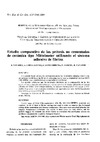Identificador persistente para citar o vincular este elemento:
https://accedacris.ulpgc.es/jspui/handle/10553/73565
| Campo DC | Valor | idioma |
|---|---|---|
| dc.contributor.author | Navarro Ortiz, R. | en_US |
| dc.contributor.author | López Alonso, A. | en_US |
| dc.contributor.author | López Urrutia, J. | en_US |
| dc.contributor.author | Garcés Martín, Gerardo | en_US |
| dc.contributor.author | Navarro, E. | en_US |
| dc.date.accessioned | 2020-06-29T22:29:30Z | - |
| dc.date.available | 2020-06-29T22:29:30Z | - |
| dc.date.issued | 1986 | en_US |
| dc.identifier.issn | 0304-5056 | en_US |
| dc.identifier.other | Dialnet | - |
| dc.identifier.uri | https://accedacris.ulpgc.es/handle/10553/73565 | - |
| dc.description.abstract | Los autores hacen un estudio comparativo entre las 30 prótesis operadas con el sistema adhesivo de fibrina y las 10 sin él, colocadas con la técnica original del profesor MITTELMEIER, pero añadiéndole el sistema adhesivo de fibrina. Los autores concluyen que los resultados obtenidos en la comparación de las dos series son prácticamente superponibles y en sus criterios la técnica utilizando el sistema adhesivo de fibrina tiene ventajas notorias, ya que por estimulación fibroblástica la osificación llega antes y los elementos protésicos son agarrados por una vía biológicamente más correcta y menos arriesgada. | en_US |
| dc.description.abstract | Fourty cases of Total Hip replacement with the MITTELMEIER's prothesis are reported. In 20 of them a fibrine coating was used in order to improve the biological setting of the acetabulum and femoral components. Ten cases were operated following the original Mittelmeier's technique. The results in both series are very similar, but the authors suggest the valuable use of the fibrine to estimulate the ossification around the prothesis component for a quicker biological fixation. | en_US |
| dc.language | spa | en_US |
| dc.relation.ispartof | Revista española de cirugía osteoarticular | en_US |
| dc.source | Revista española de cirugía osteoarticular [ISSN 0304-5056], v. 21 (124), p. 237-248 | en_US |
| dc.subject | 321315 Traumatología | en_US |
| dc.subject.other | Prótesis de Mittelmeier | en_US |
| dc.subject.other | Cadera | en_US |
| dc.subject.other | Fibrina | en_US |
| dc.title | Estudio comparativo de las prótesis no cementadas de cerámica tipo Mittelmeier utilizando el sistema adhesivo de fibrina | en_US |
| dc.type | info:eu-repo/semantics/Article | en_US |
| dc.type | Article | en_US |
| dc.identifier.url | http://dialnet.unirioja.es/servlet/articulo?codigo=5673558 | - |
| dc.description.lastpage | 248 | en_US |
| dc.identifier.issue | 124 | - |
| dc.description.firstpage | 237 | en_US |
| dc.relation.volume | 21 | en_US |
| dc.investigacion | Ciencias de la Salud | en_US |
| dc.type2 | Artículo | en_US |
| dc.contributor.authordialnetid | No ID | - |
| dc.contributor.authordialnetid | No ID | - |
| dc.contributor.authordialnetid | No ID | - |
| dc.contributor.authordialnetid | 1615937 | - |
| dc.contributor.authordialnetid | 2436116 | - |
| dc.identifier.dialnet | 5673558ARTREV | - |
| dc.utils.revision | Sí | en_US |
| dc.identifier.ulpgc | Sí | es |
| item.fulltext | Con texto completo | - |
| item.grantfulltext | open | - |
| crisitem.author.dept | GIR Biomaterials and Biomechanics Research Group | - |
| crisitem.author.dept | Departamento de Ciencias Médicas y Quirúrgicas | - |
| crisitem.author.orcid | 0000-0003-4494-9077 | - |
| crisitem.author.parentorg | Departamento de Ingeniería Mecánica | - |
| crisitem.author.fullName | Garcés Martín, Gerardo | - |
| Colección: | Artículos | |
Visitas
111
actualizado el 09-nov-2024
Descargas
165
actualizado el 09-nov-2024
Google ScholarTM
Verifica
Comparte
Exporta metadatos
Los elementos en ULPGC accedaCRIS están protegidos por derechos de autor con todos los derechos reservados, a menos que se indique lo contrario.
